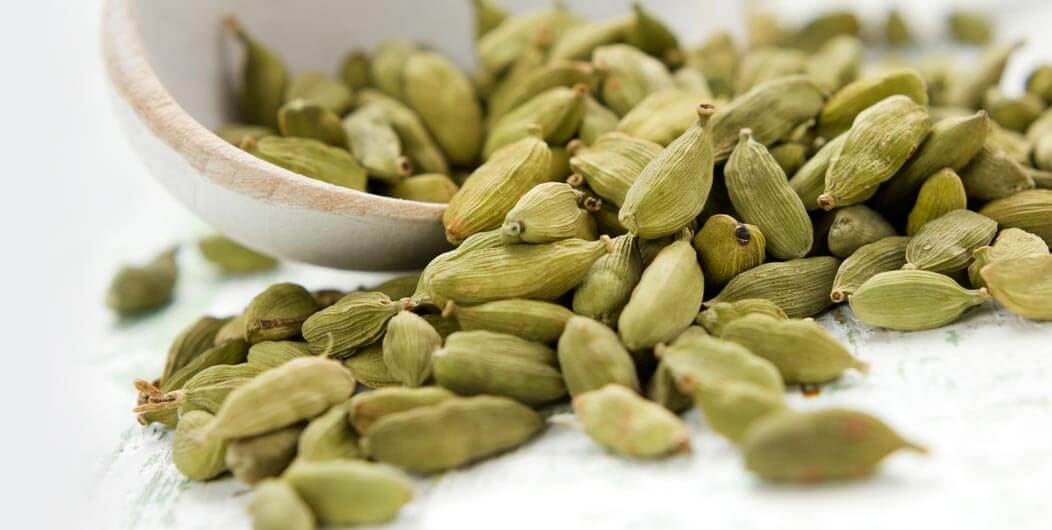
Cardamom, also called Cardamon or Cardamum, is a spice that is native to the Indian sub-continent and Indonesia. The term cardamom is used for the pods of the plants that belong to two genres; Elettaria and Amomum in the family Zingiberaceae.
There are two main types of Cardamom, namely, Black Cardamom (Amomum subulatum) and Green Cardamom or true cardamom (Elettaria cardamomum). White cardamom is the bleached version of Green cardamom. Although Green cardamom is the most available variety it fetches a higher price in the global spice markets.
The spice is often available in its whole fruit form as pods, that are spindle-shaped and have a triangular cross-section. Elettaria cardamomum, the light green variety of Cardamom is exported mainly by the Sri Lankan cardamom exporters to the global market. Producing 4000 to 5000t per annum, Sri Lanka serves around 0.1% of the global demand for Cardamom.
Due to the unique flavour of green cardamom cultivated in Sri Lanka, formed by the country’s unique terroir, green cardamom produced in Sri Lanka is known as Ceylon Cardamom.
Available as whole pods, seeds, ground cardamom powder, and essential oil, Ceylon Cardamom has many uses. Green Cardamom is the third most expensive spice in the world and is widely used as a spice and an additive in the food and beverage industry and as an ingredient in pharmaceutical, cosmetic and alternative medicine industries.
Powdered cardamom, cardamom oil and whole cardamom are widely used in flavouring food and beverage during everyday cooking, at the hospitality sector and food and beverage industry. Green Cardamom pods give away more flavour than the ground cardamom powder.
Even though it is mostly known for flavouring Asian dishes, cardamom is widely used to flavour confectionery, pastries, and baked products by the rest of the world. Many recipes call for a mixture of cardamom with other spices such as nutmeg, cinnamon, and cloves and the green coloured pod is usually removed when added to flavour a dish.
Crushed cardamom seeds are also used as an additive to tea and coffee. While cardamom tea and cardamom coffee were initially made by brewing crushed cardamom seeds with tea leaves or ground coffee, cardamom tea and coffee is now mass-produced by blending cardamom powder with loose leaf tea or ground coffee.
Cardamom powder is also used as a natural preservative in meat-based food products mainly due to its antifungal and antimicrobial properties.
Due to the many medicinal properties it contains, green cardamom essence and green cardamom essential oil are widely used as an ingredient in the pharmaceutical industry.
Essence derived from the cardamom seed is used in the production of medications that treat heartburn, intestinal spasms, irritable bowel syndrome (IBS), intestinal gas, constipation, liver and gallbladder complaints, and loss of appetite. (1) (2)
Cardamom is also an ingredient in pills that treat sexual dysfunctions and urinal complications. (3)
Although a combination of ginger, cardamom, and tarragon essential oils is used as an external application to relieve symptoms of post anaesthesia including nausea, during surgery; its effects tend to vary according to the health of the patient and the type of drugs used to induce anaesthesia.
The intense aromatic fragrance and its benefits to skin and hair health make cardamom a perfect ingredient in the production of perfumes and many other personal care products.
Cardamom oil is a widely used ingredient in many personal care products including soap, face wash, masks, and moisturises mainly due to the melanin reduction property of its compounds. (4) It is also used in perfumes and fragrance.
The cardamom seed extract is also used in some of the herbal-based cosmetic formulations including skin-whitening, anti-dandruff shampoo, hair-shine, and hair-growth preparations.
Cardamom extracts are also used in mouthwash, toothpaste, and dental gums mainly due to its refreshing aroma and antibacterial properties. (5)
The antioxidant, anti-inflammatory, and anti-bacterial properties of Cardamom make it a widely used ingredient in herbal medicine, aromatherapy, and home remedies.
Cardamom oil is used in massage oil blends since its antispasmodic properties help in soothing muscles and in aromatherapy, it is used to reduce stress and anxiety.
In herbal medicine, cardamom is often used to treat digestive problems and is used in combination with cinnamon to treat indigestion. Cardamom combined with ginger treats nausea and vomiting. Cardamom also enhances the patency of the liver while stimulating the kidney and lowering blood sugar.
Sri Lanka is well known for the variety and quality of spices it provides. From Ceylon Cinnamon to cardamom, pepper, cloves, nutmeg, and various others, the spice exports of Sri Lanka are at an all-time high.
Spices, Essential Oils & Oleoresins
Info
Directory
eMARKETPLACE
Organic Spices
Directory
eMARKETPLACE
Info
Directory
eMARKETPLACE
Nutmeg & Mace
Directory
eMARKETPLACE
Cardamoms
Directory
eMARKETPLACE
Oleoresins
Directory
eMARKETPLACE
Ginger
Directory
eMARKETPLACE
Saffron
Directory
eMARKETPLACE
Turmeric (Curcuma)
Directory
eMARKETPLACE
Vanilla
Directory
eMARKETPLACE
Condiments
Directory
eMARKETPLACE
Other Spices
Directory
eMARKETPLACE
Cinnamon
Directory
eMARKETPLACE
Cloves
Directory
eMARKETPLACE
Essential Oils
Directory
eMARKETPLACE
Spice Mixtures
Directory
eMARKETPLACE